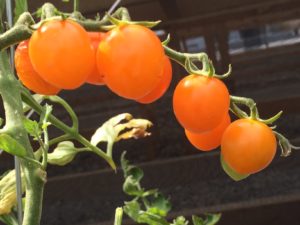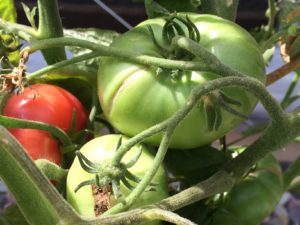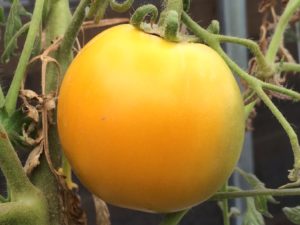GROWING TOMATOES IN MONTANA



GROWING TOMATOES
Here in western Montana we usually transplant our started tomatoes about May 10-21 as weather permits. Direct seeding may be done with the earliest varieties, but there is no guarantee of a crop. This year has been cool, with frosts still threatening in mid-May, so tender plants like tomatoes are going into our gardens a bit later than in years past. Sow your tomatoes inside during March, or buy locally grown starts. (Germination temp is 60-90 degrees, 75-85 is ideal; germination time is 5-14 days.)
Plants should be hardened-off before transplanting. A good way to do that is to expose the plants to outside conditions gradually, beginning with about two hours of shade, increasing the length of time outside every day and gradually exposing them to direct sun. This way the plants will not sunburn and will gradually toughen up before being planted out.
Your garden space for tomatoes will be most productive in full sun. The best growing temperatures are between 50–95 degrees, with 70-75 degrees ideal—tomatoes like warm days and warm nights. Their preferred soil pH is 5.5-7.5. Transplant your tomatoes out in rows at least 18” apart with 3 feet between them or into pots you can move around. Tomato cages are helpful, as they allow the plant to have support and make picking easier. You can cover individual cages with plastic or tarps if frost threatens. Protect stems from cutworms by placing jugs, cans or paper rings around them.
Keep the bed moist, not wet. Water early in the day only, allowing leaves to dry early in the day to reduce risk of disease. Blossom-end rot is caused by lack of water in development of fruit, combined with a lack of available calcium. In organic gardening, alfalfa meal and fish bone meal are great sources of calcium and other nutrients. Tomatoes enjoy steady moisture—but not too much. Regular watering, enough to keep the soil moist is excellent; too much water all at once will split fruit. Too dry of conditions between waterings will promote cracking of fruit and blossom-end rot.
Some tomato pests include: gophers; leafhoppers (which carry curly top disease); cutworms, Colorado potato beetles, flea beetles, mites, stink bugs, tomato fruit worms, and aphids. Diseases you might encounter: early blight, late blight, tobacco mosaic, fusarium and verticillium wilt. A preventative garlic spray beginning in May and continuing once a month into fall will discourage leafhoppers, which carry the disease curly top. Watch for and destroy any plants with curly top (before planting if possible).
Gather tomatoes when full sized, just ripe, and when fruit comes away from vine easily. Check/pick every 3 days to keep plants producing. The first tomatoes should be ready about July 15. After harvesting keep fruit cool, but not cold; above 55 degrees, in high humidity and out of the sun. Fruits last only 7-12 days.
